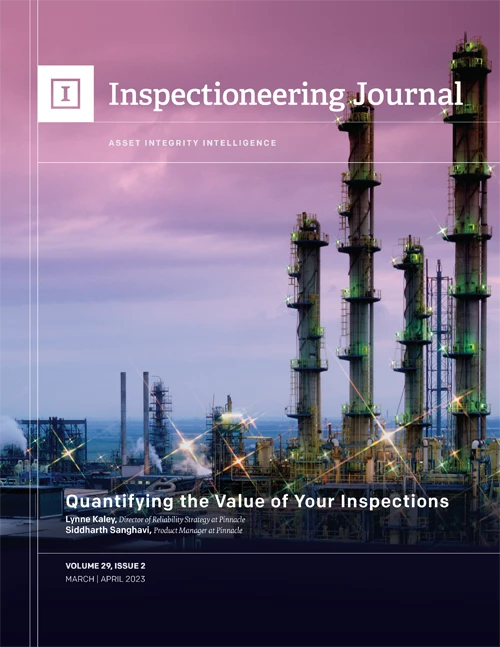Quantifying the Value of Your Inspections
Inspectioneering Journal, March/April 2023 Issue
In this article, we explore the use cases of how a quantitative model helped two facilities confidently identify which inspections could be confidently postponed, removed, or added to improve production:
Quantifying Business Value of Targeting Specific Condition Monitoring Locations (CMLs) in a Reformer
A refinery leveraged quantitative modeling to quantify the value of its CML placements and optimize its budget on value-adding CMLs. This optimization yielded a high return on investment, equating to about $800,000 in total value gain while maintaining or improving asset risk and availability.
Quantifying Business Value of Targeted Inspections in a Flare Header
A refinery experiencing leaks in one of its flare headers leveraged a quantitative model to identify the top contributors to downtime by accounting for the uncertainty associated with different inspection techniques. This optimization resulted in the refiner recognizing a cost savings of $75,000 per flare header system, extrapolated across six units for a total cost savings of $375,000 and a projected 0.4% increase in availability over the next five years.

Meet the Authors
Want to further explore how to leverage data science to drive more value from your data?
Reach out to our authors, Vyacheslav Nadvoretskiy or Andrew Waters.
The Value of Quantifying Uncertainty
You cannot maximize the value of your risk analysis without the ability to quantify the uncertainty of when an asset will fail. While monitoring various elements such as thickness measurements and flow rate can reduce uncertainty, ultimately, the value of monitoring is limited.
In this video, Ryan Sitton, Pinnacle’s Founder and CEO, walks through the impact of leveraging your data to better define whether an upcoming task should be a repair, replacement, or upgrade to reduce spending levels and downtime.
Stay in the know.
Providing data-driven insights, perspectives, and industrial inspiration from the forefront of the reliability transformation.